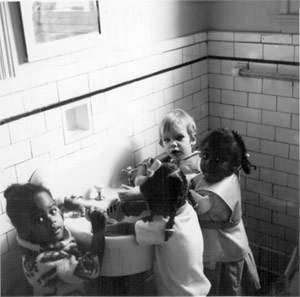Forty-seven years after it opened, all that survives of the Atlanta Cooperative Preschool Center are black-and-white pictures spread across a table. Wrinkled and warped with time, the images show white children and black children playing in a classroom and outside.
Today, there is nothing notable about children of different races playing together, but in Atlanta in 1966 it was a sign of change, according to Ruth and Sam Neff. Now living in Whitefish, the Neffs helped organize the first interracial preschool in Atlanta.
“It was wonderful,” Ruth said. “But it was a lot of hard work.”
Ruth and Sam met in Massachusetts in the late 1950s and were married soon after. In 1962, Sam, who had studied physics at Harvard, got a job doing research in New Zealand, where the couple stayed for three years.
While overseas, race relations in the United States had hit a boiling point and riots had become common across the country, especially the South. It all unfolded in the newsmagazines that would arrive in New Zealand four to six weeks later.
“We just couldn’t believe all the things happening at home and we wanted to do something to help the situation,” Ruth said.
The couple had two young children and another on the way when they moved to Atlanta. Sam began to teach physics at a black college, in hopes of increasing the number of minorities in that field.
Meanwhile, Ruth was taking care of a growing family and talking with her neighbors about the need for a nursery school in southwest Atlanta. In early 1966, Ruth and her neighbors formed the Parents’ Cooperative Nursery School (later renamed the Atlanta Cooperative Preschool Center) inside two unused rooms at Atlanta University. It would become the first interracial nursery in the city.
The parents held an auction to raise funds for the rooms’ rehabilitation. In June and July of that year, the parents plastered the walls, hung a new ceiling and painted. Everything was set to open on July 7.
But the night before the first children walked through the nursery doors a fire was set inside the old school building, destroying everything the parents had accomplished.
“(But) we rallied, because we knew we wanted a nursery school,” Ruth said.
Ten days later, the preschool opened up in the parsonage of a nearby Methodist church. The first school session ran for six weeks with 20 children, ranging in ages from 3 to 5.
 |
|
Children wash their hands at the Atlanta Cooperative Preschool Center. Photo courtesy of Sam and Ruth Neff. |
Ruth served as the school’s first organizer and often spent time working with the kids herself. Each parent with a child enrolled at the nursery tried to volunteer two days a month and help the full-time teacher who was hired. On occasion, Sam would stop by and provide the children with a basic physics lesson. Scholarships were offered to parents who didn’t have enough funds to send their children, Ruth said. Because of that, the school had a diverse group of children from different economic backgrounds.
Although some places in the Deep South might have been resistant to an interracial nursery school during that time, Sam said locals welcomed it.
“The people in Atlanta were open to change,” he said.
Sam and Ruth eventually moved away from Atlanta after he took another teaching job in Indiana. The preschool continued for another 25 years.
Years later, Sam and Ruth have the memories of their front row seat to the historic cultural changes that shook the South during that time. That and a box of black-and-white photos.